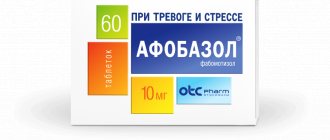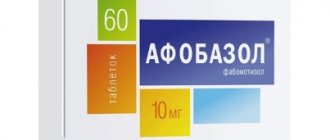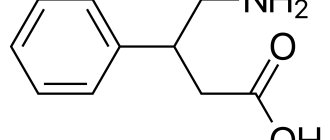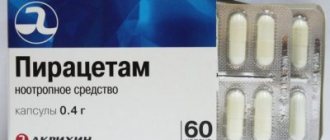Vegetative-vascular dystonia is a polysymptomatic complex consisting of various groups of manifestations. Not the least role in this is given to psycho-emotional imbalance, which can lead to functional failures of many organs. Afobazole for VSD helps to cope with these kinds of symptoms: it eliminates anxiety and feelings of restlessness, and harmonizes the state of the nervous system. With the help of Afobazole, you will significantly ease the course of the disease and be able to avoid its crises.
More about vegetative-vascular dystonia
This is a syndrome accompanied by disruption of the autonomic nervous system and functional failures of many organs. Vegetative-vascular dystonia is not a separate disease, but is considered a complex of symptoms of various etiologies.
A similar condition was first described in 1918 in America by the doctor B. Oppenheimer, who called it “neurocirculatory asthenia.” In Soviet times, the syndrome was called vegetative-vascular dystonia.
In the modern world, its manifestations are united under the name “neurocirculatory dystonia”. According to the ICD-10 classification, this is expressed by the concept of “somatoform dysfunction of the autonomic nervous system.”
Symptoms of this condition are quite varied:
- pain in the heart area, palpitations;
- breathing disorders in the form of shortness of breath or suffocation, lack of air;
- constant headaches, dizziness;
- poor sleep;
- pain in joints, muscles;
- fatigue, weakness, malaise, loss of consciousness;
- convulsive twitching of arms and legs, tremors;
- violation of thermoregulation;
- low-grade fever up to 37°;
- increased sweating, sensations of heat, dry mouth.
Of course, such manifestations of VSD can have real causes: chronic infections, intoxication, hypoxia, prenatal and postnatal lesions, osteochondrosis of the cervical spine with impaired blood supply to the brain.
But most often such symptoms become a manifestation of neuropsychic disorders: hysteria, suspiciousness, increased impressionability, nervous exhaustion.
This is also facilitated by various kinds of events that cause emotional stress and throw the nervous system out of balance. In this case, a number of symptoms are joined by others that indicate mental imbalance:
- sense of anxiety;
- obsessive thoughts and phobias;
- fear of death;
- feeling like you're going crazy;
- disbelief in the reality of what is happening.
Rather, it is nervous disorders that cause painful and unpleasant sensations in other organs. This fact is confirmed by the fact that during the examination, organic disorders in the declared organ are not recorded.
In situations where nervous tension goes beyond acceptable limits and mental state is disturbed, Afobazol will help. The drug is an anxiolytic, that is, it has
ability to eliminate anxiety. Along with it, irritability, excessive concern and groundless fears go away.
Relieving nervous tension, the drug helps to relax, reduce anxiety and improve sleep, and eliminates obsessive fears. With the normalization of the nervous system, symptoms of dysfunction of internal organs disappear. In addition, cognitive functions improve: memory and concentration.
Afobazole is a safe drug for the treatment of anxiety in general practice
Avedisova A.S.
Anxiety symptoms are among the most common mental phenomena. The breadth of the range of anxiety manifestations - from adaptive anxiety (adjustment disorder) to neurotic anxiety (generalized anxiety disorder - GAD) to severe psychotic states of endogenous origin, accompanied by anxiety disorders, indicates that these symptoms are observed both in most people in everyday life and in patients of general therapeutic and psychiatric practices.
The proximity of the anxious state to normal human existence (for example, anxiety as the “engine” of evolution and a determining link in survival) causes significant variations in the frequency of these states - from 2-4 to 20% in the population, at the same time showing their extremely high prevalence. The main psychophysiological feature of anxiety is that it is a generalized reaction that covers the entire body.
The central element of anxiety is the cognitive component, which is a feeling of diffuse vague fear and anxious anticipation, vague anxiety, uncertainty, tension, difficulty concentrating, anticipation of danger, threat. The substantive uncertainty of the phenomenon of anxiety is subjectively expressed in the feeling of its painfulness, difficult tolerability, accompanied by a feeling of uncertainty and helplessness in the face of danger. Uncertain anxiety manifests itself in concern for many different insignificant reasons, which in the minds of patients acquire an unlawful meaning, promising, with a certain degree of probability, a threat, misfortune to them or their loved ones. A frequent manifestation of the cognitive component of anxiety is worry that the patient or his relative will soon get sick, or that an accident will happen to them, as well as various other worries and apprehensions. Anxiety is accompanied by a feeling of internal tension, hyperesthesia, irritability, anticipation of inevitable troubles, and a feeling of intractability of emerging problems.
The second component of anxiety is somato-vegetative, associated with the appearance of a variety of unpleasant and painful sensations in various organs and organ systems (nausea, tachycardia, dry mouth, sweating, breathing disorders and many others, usually associated with hyperreactivity of the autonomic nervous system). These somato-vegetative symptoms, through a “feedback” mechanism, are anxiety-precipitating factors and further increase internal tension and anxiety.
The third component of anxiety - behavioral/motor - includes a variety of changes in motor activity: avoidance behavior (for example, stressful events - horror films, bad news, etc.), fussiness, agitation, tremor or, conversely, lethargy.
The distinction between anxiety and fear is usually based on the criterion introduced into psychiatry by K. Jaspers. Anxiety is felt out of connection with any stimulus (“free-floating anxiety”), cannot objectify danger, is pointless and directed to the future; the object of anxiety is a non-specific, “uncertain”, “objectless” danger (repressed into the unconscious). The stronger and more intense the anxiety, the more impaired is a person’s ability to distinguish the subjective from the objective, to adequately recognize and correctly evaluate objects in the external world. In contrast, fear is correlated with a specific stimulus and object, is filled with specific content and is objective.
Patients with anxiety are the most frequent visitors to clinics, and when one considers the fact that anxiety symptoms account for approximately one third of all consultations in general practice, one can imagine the enormous amount of time that must be spent on outpatient treatment for such patients.
Anxiety, as a rule, acts either as the main component of various psychopathological syndromes, or as the basis on which other psychopathological or psychosomatic disorders are formed.
Most often, patients with anxiety, which is an obligatory symptom of adaptation disorder, turn to general practitioners. This disorder (according to ICD-10 diagnostic criteria) occurs during the period of adaptation to a significant life change or stressful life event. A huge number of life situations can cause adaptation disorders accompanied by anxiety. These are those emotional stresses that are in the range of normal human experiences, for example, the birth of a child, starting school, marriage, job loss, divorce, illness, conflicts in the family, at work, exams, illness of a family member, loss of a loved one (grief reaction) , unemployment, change of residence and much more. A particularly important problem is adaptation disorders that occur with anxiety and occur in patients with somatic diseases. Stressful factors in this case may include hospitalization, a new diagnosis, relapse of the disease, diagnostic procedures and operations, and many others (by the way, doctors usually underestimate the role of these stressful events in the patient’s life).
Another disorder that general practitioners often “face” with is GAD, in the structure of which anxiety is observed in its most “pure” form. This disorder, in accordance with the ICD-10 classification, is characterized by anxiety that is generalized and persistent, occurring regardless of any specific environmental circumstances (even without their preference), that is, it is “not fixed.” In children, generalized anxiety often manifests itself as recurrent somatic complaints and a need to be reassured. One of the distinctive features of GAD is its course, namely its chronic or wave-like nature (with minor periods of worsening or weakening of existing symptoms).
However, when realistically assessing the situation, it should be emphasized that a general practitioner who is faced with the issue of treating anxiety disorders, when choosing therapy, is more likely to rely on the severity of the manifestations of the disease rather than on the classification of diseases. In addition, the speed of decision-making on treatment tactics may be decisive for the prognosis of anxiety. The experience of psychiatric practice acquired during wartime showed that difficulties in adaptation have more favorable consequences in the case of immediate initiation of treatment, including medication. It should be emphasized that therapy is required in cases where the state of anxiety reaches a certain threshold, becoming a maladaptive factor, complicating the patient’s ability to work, or contributing to an exacerbation of the prognosis of concomitant somatic diseases.
Several categories of patients with anxiety disorders can be distinguished at an appointment with a therapist and other general specialists who require medication assistance:
- patients with anxiety leading to decreased performance (as part of adjustment disorders or GAD);
- patients with progressive or chronic somatic diseases whose level of anxiety interferes with appropriate treatment;
- patients whose level of anxiety makes diagnostic assessment or diagnostic procedures difficult;
- patients with psychosomatic diseases (hypertension and others), in the genesis and course of which anxiety disorders have an important pathogenetic significance;
- some patients with somatic diseases, in which stress and anxiety can worsen the course of somatic pathology.
The drugs of first choice in the treatment of anxiety have long been benzodiazepine anxiolytics. The rapid onset of anxiolytic action ensured their high effectiveness in anxiety states. However, the downside of this phenomenon was the high risk of abuse and the possibility of complications with addiction phenomena. In this regard, the most common BDZs are limited in terms of use to 2-4 weeks, which is often not enough for the treatment of anxiety disorders. Due to worldwide restrictive guidelines for the use of benzodiazepines, no new anxiolytic has been registered in any country since 1986. If we compare this situation with other psychotropic drugs, the synthesis of which has recently been “experiencing” a rapid rise (for example, over the last 3 years, 3 new antidepressants have been registered, over the last 6 years - 5 new antipsychotics), it is quite obvious that as psychopharmacologists and doctors, Likewise, patients have been waiting for 20 years for the appearance of an innovative anxiolytic, devoid of the undesirable effects of benzodiazepine derivatives.
Such a drug, Afobazole, was developed at the Research Institute of Pharmacology of the Russian Academy of Medical Sciences based on the original pharmacogenetic concept of the anxiolytic effect, as well as ideas about a new neurochemical target for the pharmacological correction of emotional stress reactions, and began to be produced by Masterlek JSC. Afobazole is not a benzodiazepine receptor agonist, which is an innovative component of its mechanism of action. At the same time, it prevents the development of membrane-dependent changes in the GABA-benzodiazepine receptor complex, observed during the formation of anxiety and emotional stress reactions and leading to a decrease in the availability of the benzodiazepine receptor site to the corresponding ligand.
Afobazole has a combination of distinct anxiolytic, vegetative stabilizing and moderately pronounced activating properties. The anxiolytic effect of Afobazole is not accompanied by hypnosedative effects (sedative effects are detected in Afobazole in doses 40-50 times higher than the ED50 for anxiolytic action). The drug does not have muscle relaxant properties or a negative effect on memory and attention. With its use, drug dependence does not form and withdrawal syndrome does not develop, which allows this drug to be classified as an over-the-counter drug. The spectrum of clinical and pharmacological effects of Afobazole is presented in Figure 1.
The therapeutic effect of Afobazole begins to manifest itself from the first days of treatment, reaching a clinically significant level by the end of the second week of therapy. Patients become calmer and more anxious. Unlike benzodiazepines, the effect of which is manifested mainly in the reduction of somatic anxiety, when using Afobazole, not only a reduction of somatic equivalents of anxiety is noted, but also cognitive ones.
Therapy with Afobazole is practically not accompanied by side effects. Those that are rarely observed (headaches and nausea) are mildly expressed, do not require special medication correction, drug withdrawal and go away on their own. It should be especially noted that the drug does not cause sedation, which allows patients to maintain their usual activity and contributes to their high compliance. In this regard, Afobazole, unlike benzodiazepines, can be used in persons whose professional activities require the preservation of attention and memory functions, including when driving a car.
An important feature of Afobazole is the absence of properties in the drug that determine the development of the “withdrawal” syndrome upon abrupt cessation of treatment. This distinguishes Afobazole from traditional benzodiazepine anxiolytics and allows its use for a long time in accordance with the standards of treatment of generalized anxiety.
Despite the fact that Afobazole is already widely used to treat patients with anxiety disorders, its study continues. The fact is that experimental data suggest that the drug has a number of other therapeutic effects that are very important for clinical practice - neuroprotective, antimutagenic, stress-protective, immunomodulatory. Such work is already being carried out in leading Russian institutes and clinics.
How does Afobazol work?
The drug is classified as a tranquilizer, but it should be noted that it stands out compared to its other counterparts.
Most members of this group act on benzodiazepine receptors. In this regard, there are some side effects of such drugs, such as: drowsiness, muscle atony, decreased concentration. Cases of addiction and withdrawal syndrome are common. But Afobazol acts very gently, bypassing all of the above complications. It has no effect on benzodiazepine receptors, acting directly on GABA-sensitive neurons and increasing their sensitivity.
GABA (gamma-aminobutyric acid) suppresses increased nervous excitability of the brain. This is the leading neurotransmitter that is responsible for inhibition processes in the central nervous system. It inhibits the action of acetylcholine and adrenaline, which cause emotional outbursts and pain. But at the same time, GABA activates the energy potential of brain tissue, stimulates blood circulation in it and the absorption of glucose and oxygen by cells, that is, it improves trophism or nutrition of the brain.
Afobazole reduces the activity of subcortical centers, such as the thalamus or hypothalamus, which are responsible for human emotions.
By taking Afobazole, you will protect your nervous system without falling into a stupor.
Afobazole and alcohol: compatibility
After using Afobazole tablets for nerves, it is unacceptable to drink alcohol. Any medications that directly affect the nervous system should not be combined with alcohol.
Alcohol can greatly enhance the effect of an anxiolytic, which will result in overdose, poisoning, or severe intoxication of the body.
There are known cases of death when large doses of Afobazole are combined with alcoholic beverages.
Sphere of influence
The drug has a milder and more restrained effect than other tranquilizers. And the question of whether Afobazol will help with severe mental disorders remains open. But he is able to cope with nervous overstrain during VSD.
In addition, experts recommend taking Afobazol for:
- neurasthenia;
- anxiety disorders;
- with psychosomatics;
- alcohol and tobacco withdrawal;
- premenstrual syndrome.
Sometimes people cannot even explain what triggered the emergence of such feelings. However, at the physiological level, this is explained quite simply: a surge of adrenaline entails a sharp stimulation of nervous processes and the functioning of internal organs, and since its action is systemic, the entire body is involved.
PA is mainly mental in nature. It can be caused by stress, nervous overload, emotional tension, as well as hormonal imbalances, alcohol abuse and smoking.
But it should be noted that VSD and panic attack go hand in hand. And often the latter is a manifestation of neurocirculatory dystonia during its exacerbation.
The role of Afobazole during a panic attack is to suppress the release of adrenaline and maintain it at the proper level.









